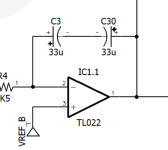squirrelboy
Member
Yeah, it’s weird. The pedal works fine for approximately 30 seconds each time I unplug and plug the power back in, and then after 30 seconds it seems like the LFO stops oscillating.
Any ideas?
Any ideas?

Don't get your hopes up hahaOooo I am going to check this. Thanks!
I just replaced it with 150k and it did not solve the problem. Haha. I did get my hopes up!Don't get your hopes up haha
It's just something I would check for a fault like this where it intermittently cuts out
I've came across it twice once on an ehx holy grail and once on a tube pedal I'd built because I didn't heatsink the regulator but obviously the tube heaters draw a lot more current
This is one of the few things I did know. HahaI don't know if anyone told you but when you number the pins on an IC the convention is that you count top left as one, go down that column and then back up the right hand side. So on an 8-pin IC the lowest right hand pin is pin 5 and the top right hand pin is pin 8. It looks from your voltages that you are starting at the top for both sides. I apologise if you already knew this! And worry about your voltages!
Good thinking on isolating the problem!UPDATE:
Using the schematic, I built the LFO section of the circuit on a breadboard and patched it into the pedal using an alligator clip. Pedal works perfectly now. So, the problem is definitely with the LFO on the PCB. Now that I know a bit more about LFOs, I am going to see if I can figure out what I did wrong on the PCB.

I like how you are working through this. Thank you for sharing the stepsUPDATE:
I had some time last night to continue to investigate what I might have done wrong on the PCB. I learned that when the power was on, I was getting continuity between pins 1 and 2 of the TL022.
I checked whether I was getting continuity between pins 1 and 2 of the TL022 on the breadboarded version, and I was NOT.
I looked at the schematic, and I don't think I should be getting continuity between pins 1 and 2 of the TL022:
View attachment 70497
So, I decided to try to figure out why I was getting continuity on the PCB. I determined that Pin 1 of the TL022 was getting continuity with the anode of C30 AND the anode of C3. Pin 2 was getting continuity only with the anode of C3.
To correct this, I removed C30 and C3 from the PCB and then soldered the cathode legs of 2 33uF capacitors together and then soldered the anode of one of them to Pin 1 and the anode of the other one to Pin 2. Now, I am not getting continuity between pins 1 and 2 of the TL022. However, still no oscillation. So, the investigation continues.
Also, I should probably say that I am kind of just posting all of this for posterity or in case someone else has the same problem and my investigation is useful to them.
The investigation will continue tonight once my 14 month old goes to sleep.
When testing for Continuity, you should not have the Power connected to the circuit or you will get a false reading.UPDATE:
I had some time last night to continue to investigate what I might have done wrong on the PCB. I learned that when the power was on, I was getting continuity between pins 1 and 2 of the TL022.
I checked whether I was getting continuity between pins 1 and 2 of the TL022 on the breadboarded version, and I was NOT.
I looked at the schematic, and I don't think I should be getting continuity between pins 1 and 2 of the TL022:
View attachment 70497
So, I decided to try to figure out why I was getting continuity on the PCB. I determined that Pin 1 of the TL022 was getting continuity with the anode of C30 AND the anode of C3. Pin 2 was getting continuity only with the anode of C3.
To correct this, I removed C30 and C3 from the PCB and then soldered the cathode legs of 2 33uF capacitors together and then soldered the anode of one of them to Pin 1 and the anode of the other one to Pin 2. Now, I am not getting continuity between pins 1 and 2 of the TL022. However, still no oscillation. So, the investigation continues.
Also, I should probably say that I am kind of just posting all of this for posterity or in case someone else has the same problem and my investigation is useful to them.
The investigation will continue tonight once my 14 month old goes to sleep.
Oh shoot. Thank you for the tip!When testing for Continuity, you should not have the Power connected to the circuit or you will get a false reading.
Also the pots should be at approx the middle rotation as sometimes they effect the reading when fully C.C.W
